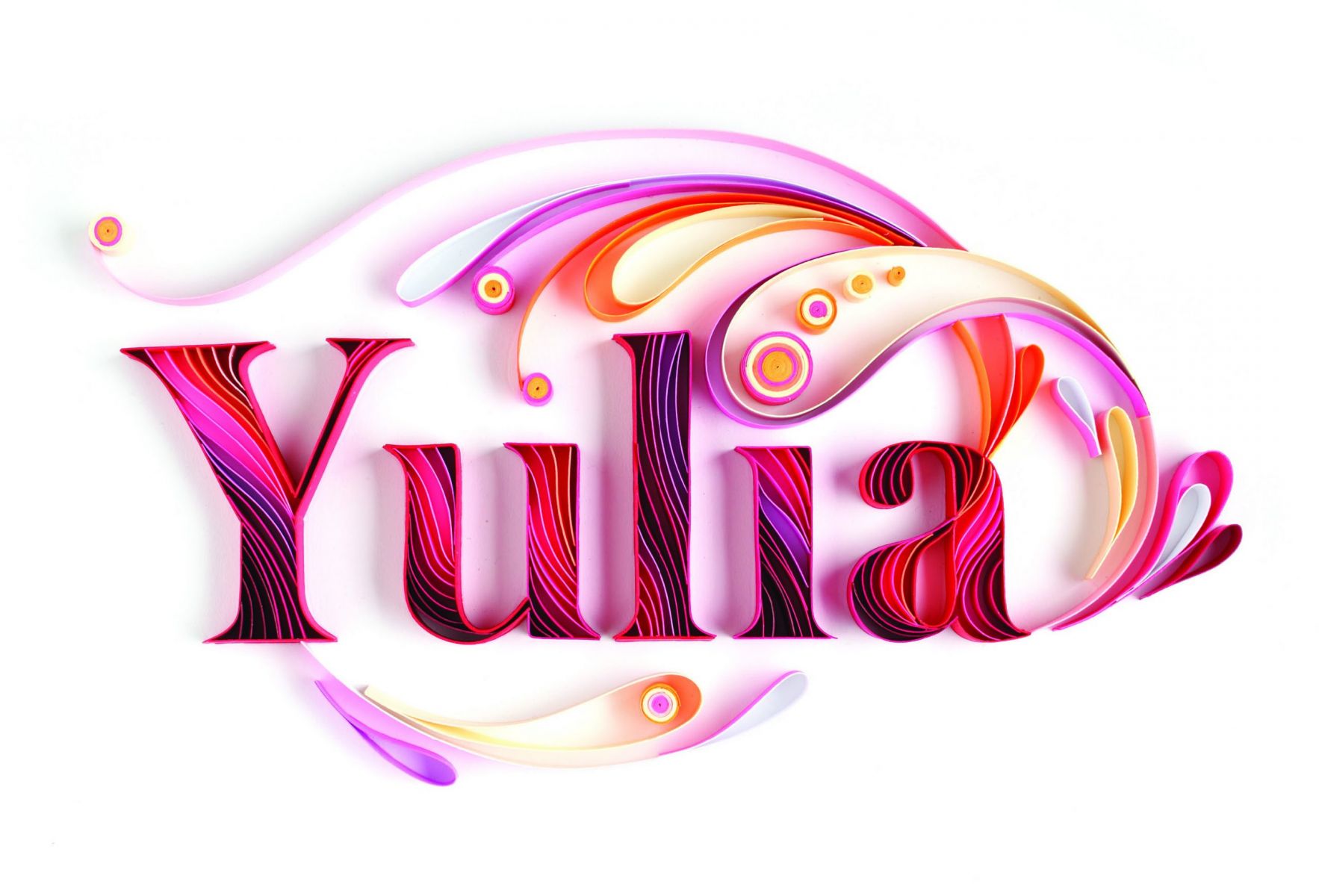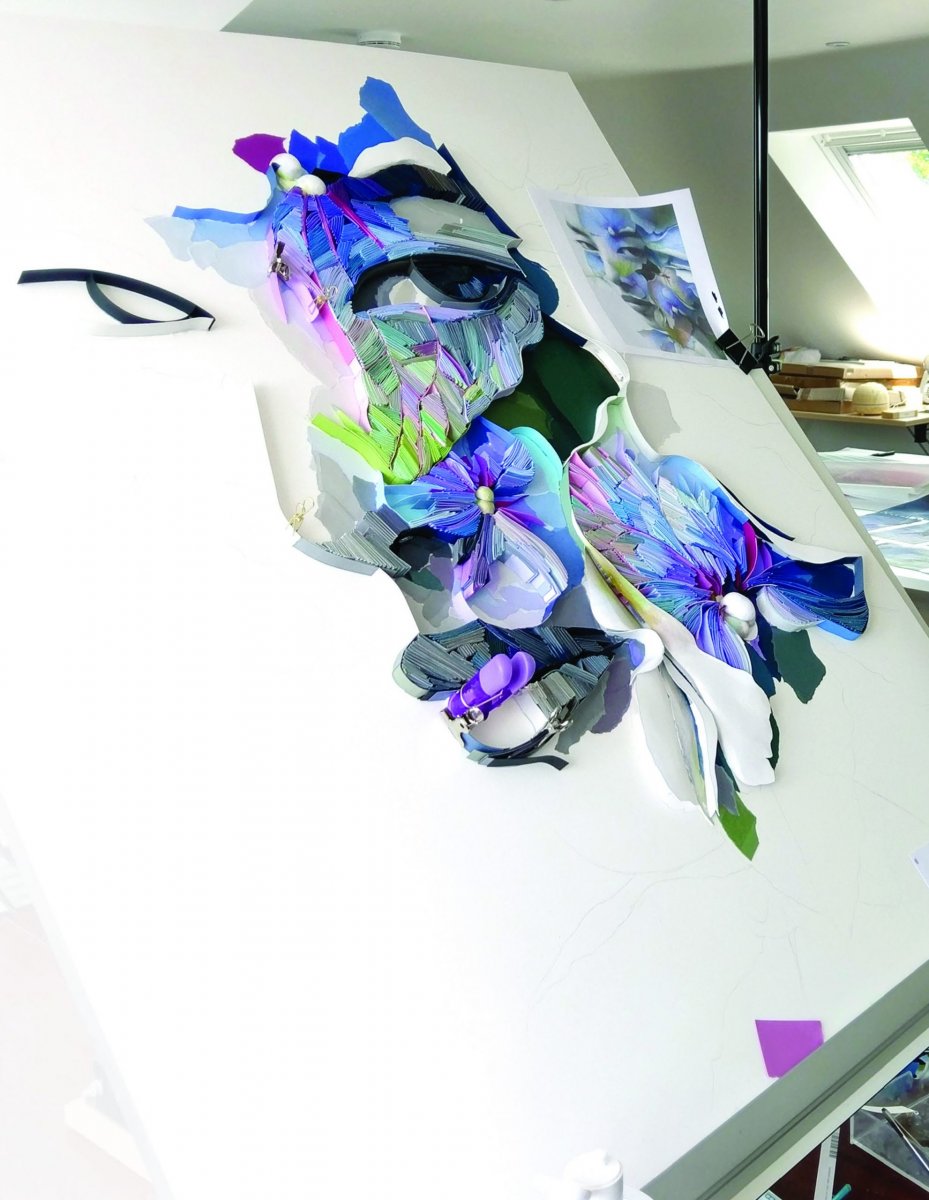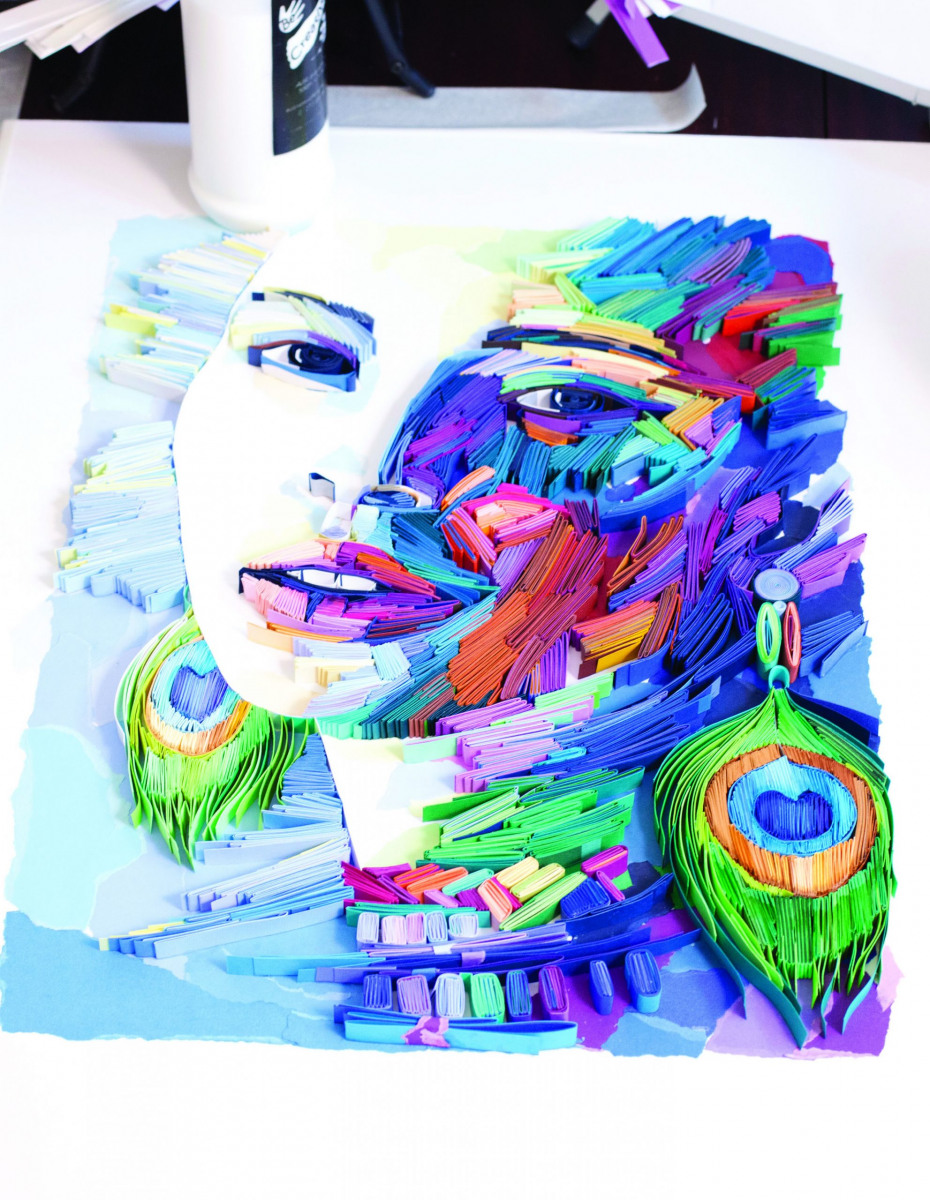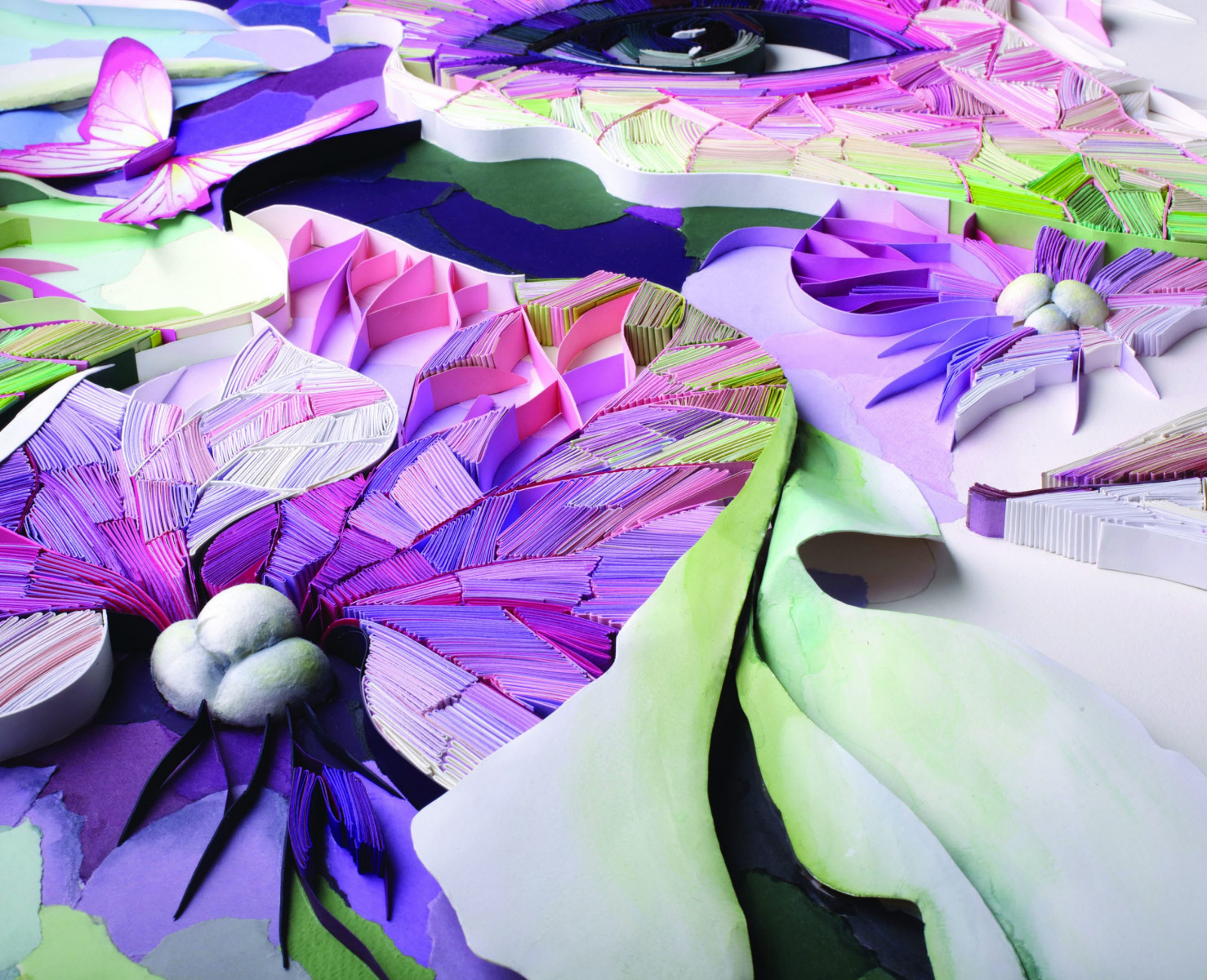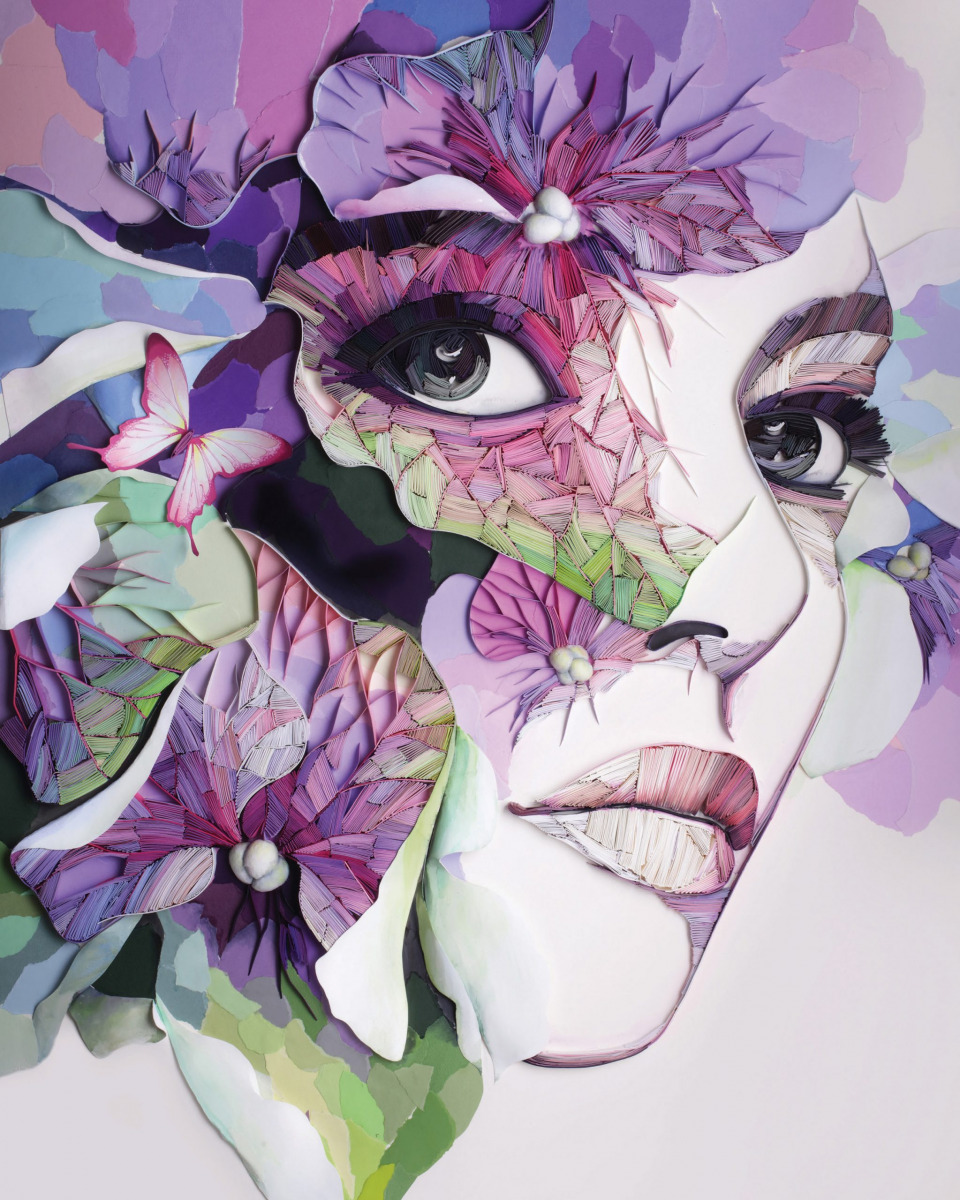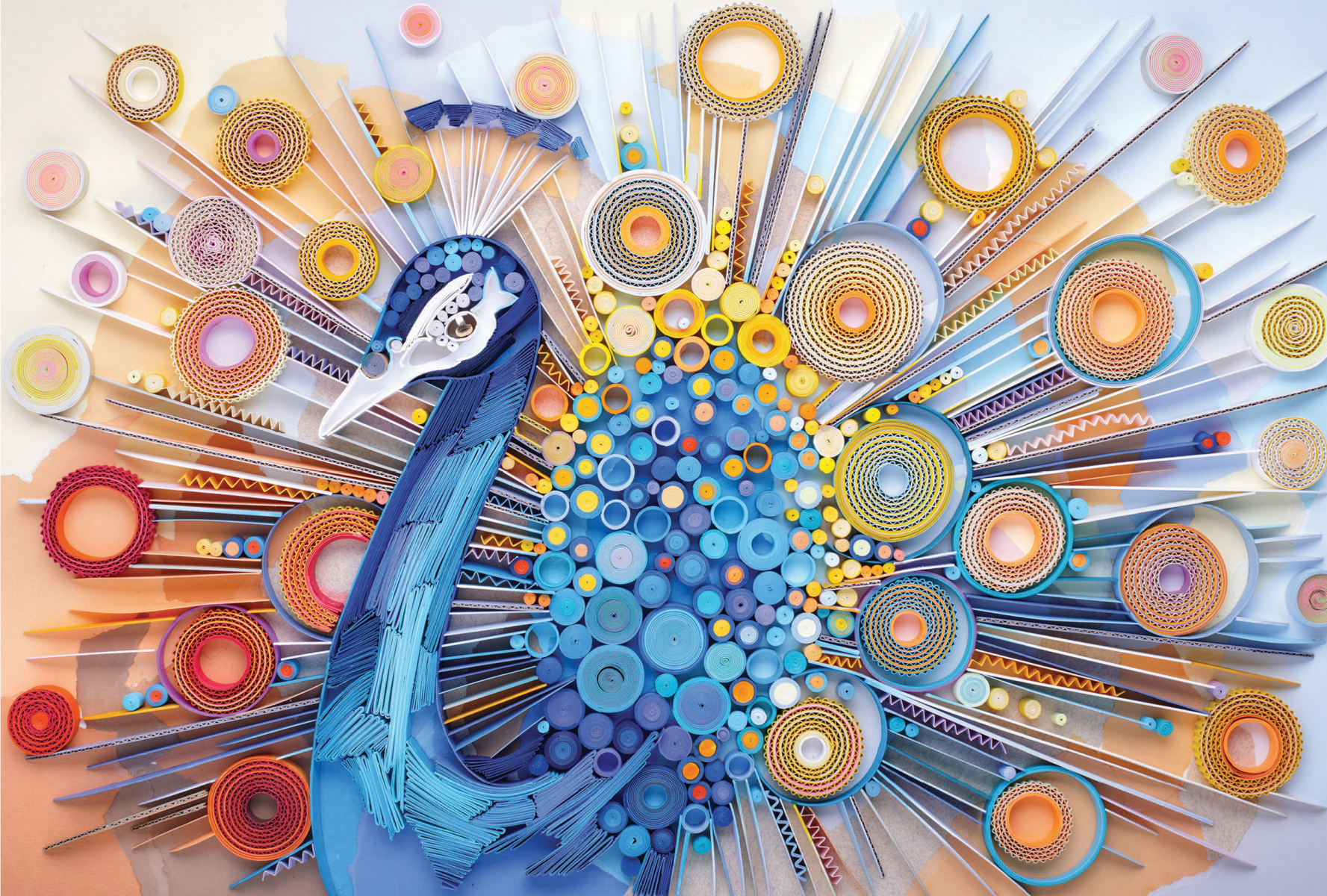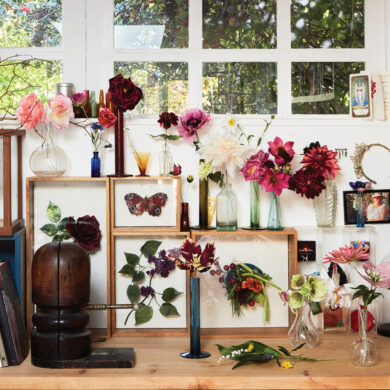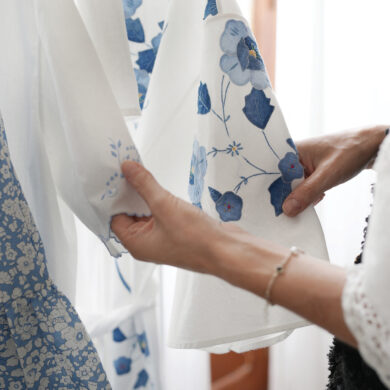As long as I can remember, paper always held a special fascination for me. But if someone had told me all those years ago that I would become a paper artist and won’t be even remotely interested in using any other materials, I would have never believed that.
Over the years I’ve tried many different methods and techniques of working with paper, just as a hobby ‘on a side’ because I was convinced that “all things digital” was the only reliable way to make a living. Only towards the end of my master’s degree in graphic communications, I realised that I would rather try to become an illustrator.
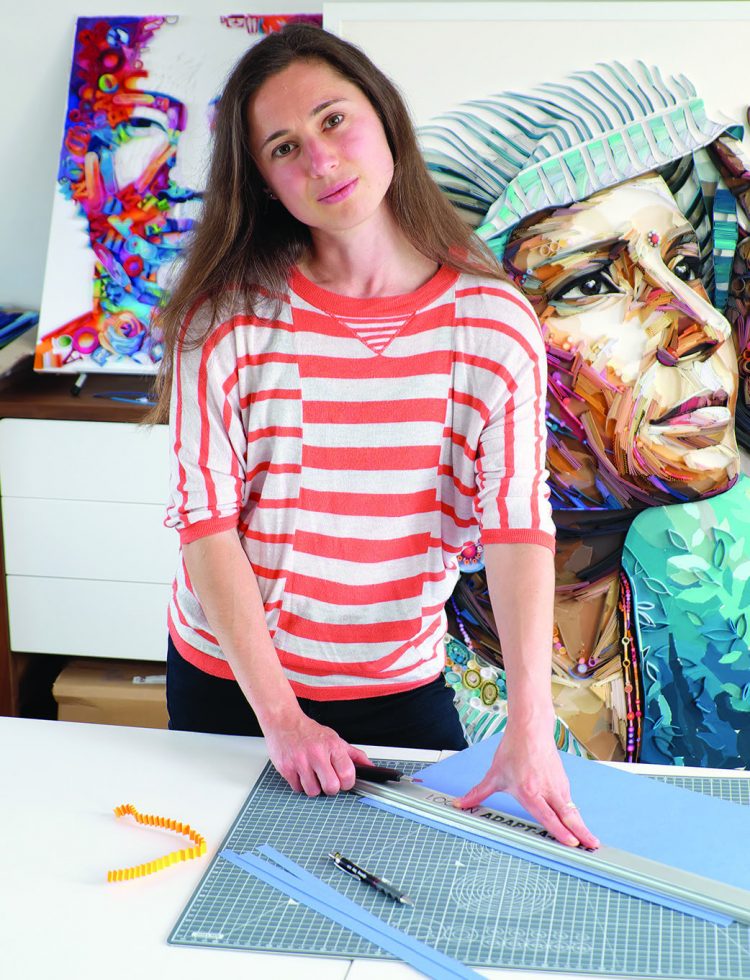 After finishing my studies, I spent about 1.5 years drawing and searching for my unique style. Once I thought that I found my illustrative voice, I decided to put together a little self-promotional booklet with my best works in order to get editorial commissions from magazines and newspapers. The only crucial thing missing was an eye-catching cover image that would make certain my booklet would be noticed. I decided to illustrate my name for the cover and created several hand-drawn versions of my name Yulia, but none of them seemed to be good enough, so I discarded them all. What happened next turned my career aspirations upside down.
After finishing my studies, I spent about 1.5 years drawing and searching for my unique style. Once I thought that I found my illustrative voice, I decided to put together a little self-promotional booklet with my best works in order to get editorial commissions from magazines and newspapers. The only crucial thing missing was an eye-catching cover image that would make certain my booklet would be noticed. I decided to illustrate my name for the cover and created several hand-drawn versions of my name Yulia, but none of them seemed to be good enough, so I discarded them all. What happened next turned my career aspirations upside down.
I can’t remember how exactly (because back then I never even heard the term Quilling), but I cut some paper sheets into strips and glued the outlines of my name, adding more coils and frills inside. The work took me a couple of hours and once it was done, I realised that I’m definitely on to something much more interesting than all my previous drawn illustrations. Immediately I abandoned the booklet idea, and instead emerged myself into this new territory of making art with strips of paper. It just felt so right, like I’ve finally arrived home…
I use various clips to hold folded papers together and in place for about 10 minutes until the glue dries and the papers can hold a bended shape on their own.
Super-Fast Forward: I was lucky to collaborate with international brands and companies, and work on exciting projects, learning and perfecting the techniques along the way.
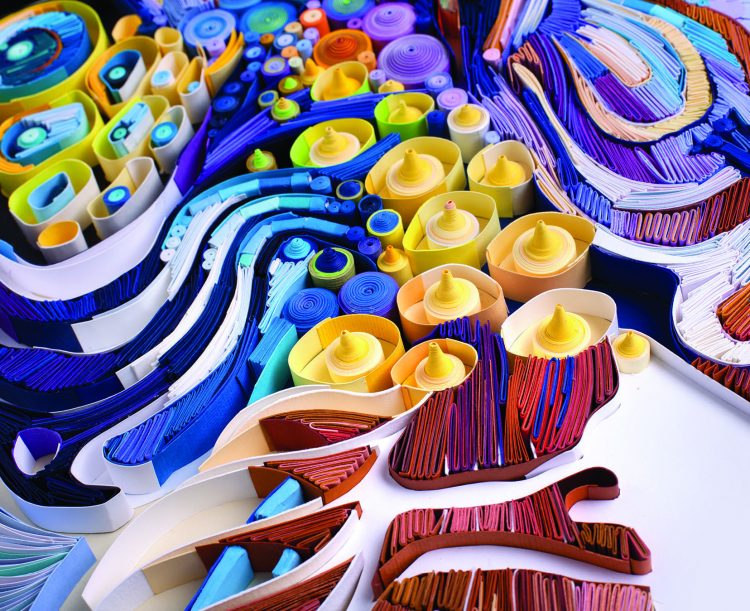 The key difference of my way of working with paper strips is that by using heavy paper and card stock, I am able to work with single segments of a paper strip without the need to roll it into a basic shape (unlike traditional Quilling that uses very thin light paper that must be rolled into some shape to ensure its stability). Heavy paper allows me to shape a strip into a single line, that holds its shape and is stable on the surface when glued down. This means that I can introduce new colour with every next strip added and create any design without limitations: basically, if you can draw a line with a pencil, you can then repeat that line with a strip of heavy paper creating a 3-dimentioanal line. That’s what I call “drawing with paper strips”.
The key difference of my way of working with paper strips is that by using heavy paper and card stock, I am able to work with single segments of a paper strip without the need to roll it into a basic shape (unlike traditional Quilling that uses very thin light paper that must be rolled into some shape to ensure its stability). Heavy paper allows me to shape a strip into a single line, that holds its shape and is stable on the surface when glued down. This means that I can introduce new colour with every next strip added and create any design without limitations: basically, if you can draw a line with a pencil, you can then repeat that line with a strip of heavy paper creating a 3-dimentioanal line. That’s what I call “drawing with paper strips”.
My paper art practice is a journey. It evolves and changes constantly, and I learned to readily allow these transformations to happen.
Several years ago, my techniques made another evolutionary turn from “drawing” to “painting” with paper. Painting with paper means imitating brushstrokes with tightly packed strips of paper, achieved by combining different colour strips in a similar way as mixing paints on a palette. This new technique comes as close to real painting as possible, but with added quality of a third dimension.
Obviously combining coloured paper strips in this manner won’t give you a smooth new colour that you can get when mixing paints, it is more of an optical illusion explained by limits of the human eye’s ability to perceive alternating colour stripes. At a certain distance, the eye struggles to discern individual stripes and begins to perceive the new blended colour as a whole.
Creating a tight stroke-like shape (or pack) is simple:
- bend a strip or several strips together multiple times, alternating
the direction of the bend (if you let go of the strip at this point, you’ll
get a zig zag shape);
- dip it into a puddle of glue (I use PVA);
- place onto the background surface;
- and secure with a clip until the glue dries completely.
For a more detailed look into my process, you can watch any of my YouTube videos, including this one: https://youtu.be/WjeDAlilSfY
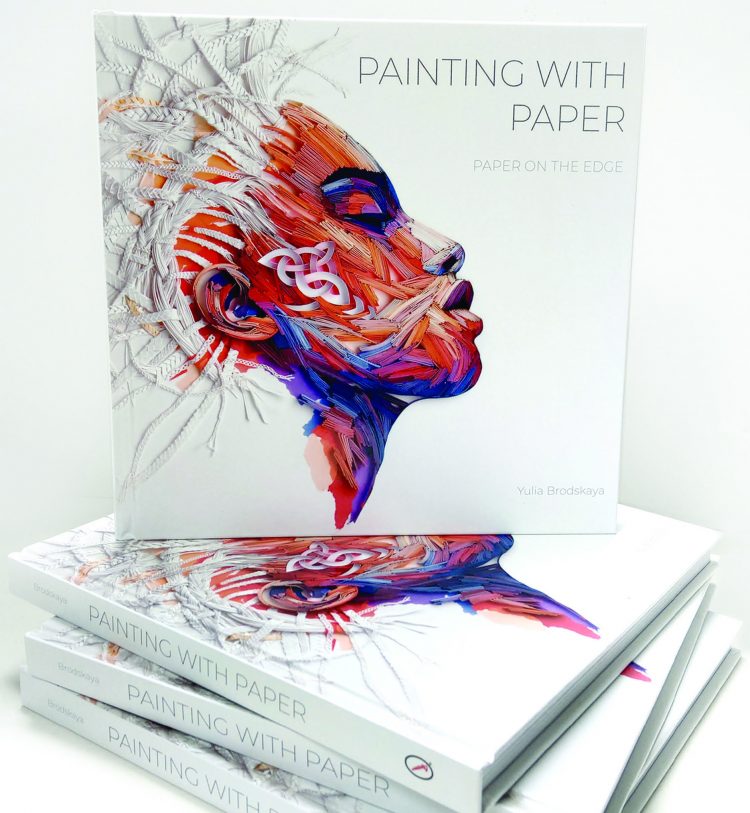 In my book ‘Painting with Paper,’ I describe my journey and methods in more detail, however it is not a step-by-step project book because what I really care about is creativity (partially because there is a certain stigma around crafts like Quilling when people think there are right and wrong ways to do it and learning exact techniques from someone is essential). What I’m trying to encourage through sharing my experience and practical advice, is creative freedom: we create in order to feel joy from making something beautiful with our own hands. This feeling of joy is many times stronger when you create art inspired by something that moves you deeply as a person. That’s why it is important not to get stuck and develop a habit of needing somebody else to outline and plan every creative decision for you. The real unique creativity comes from inside when you find the courage and learn to make your own decisions (and, sometimes, mistakes), but ultimately create the art that is a unique expression of yourself rather than a replica of somebody else’s vision.
In my book ‘Painting with Paper,’ I describe my journey and methods in more detail, however it is not a step-by-step project book because what I really care about is creativity (partially because there is a certain stigma around crafts like Quilling when people think there are right and wrong ways to do it and learning exact techniques from someone is essential). What I’m trying to encourage through sharing my experience and practical advice, is creative freedom: we create in order to feel joy from making something beautiful with our own hands. This feeling of joy is many times stronger when you create art inspired by something that moves you deeply as a person. That’s why it is important not to get stuck and develop a habit of needing somebody else to outline and plan every creative decision for you. The real unique creativity comes from inside when you find the courage and learn to make your own decisions (and, sometimes, mistakes), but ultimately create the art that is a unique expression of yourself rather than a replica of somebody else’s vision.
“Do what you love, love what you do.”
In my own practice these days, I’m all about exploring large scale. I must say that it is not LARGE universally speaking, but large for the techniques that I use, e.g., my recent works are about 1×1.5m. Of course, it is possible to fill in a large space with hundreds of tightly rolled circles or coils however, my personal interest lies in conveying a deeper emotional complexity into larger paper artworks, ensuring that the larger scale does not become a goal in itself.
I also feel a new urge in choosing my subject matter. It feels that depicting just a beautiful flower, a pretty shell, or a decorative wave on its own is simply “not enough”. A human presence is needed to deepen the visual experience, the feel and emotional charge coming from the artwork, so I end up combining the natural motifs with human faces. I might create natural elements (flowers, birds) on their own when I need a quick break from the challenges of working on human faces, but I still think that I create my best work when I combine the two together.
Very recently my paper art practice made another peculiar turn. During the Pandemic, I created a project that revived my ‘pre-paper’ graphic design abilities. Together with a couple of friends I created Paper Mingle—a mobile puzzle game/app that brings tactile hand-made feel of papercraft into a digital universe.
In my daily life I constantly face the fact that not that many people are familiar with paper art. So many times, I find myself trying to explain what I actually do, what is Quilling, why it is so meaningful to me, and why it is that I spend every free moment fidgeting with paper strips. Seeing the widespread popularity of many hit mobile games, I thought that it would be cool to create a new game inspired by all things paper, that will become a little gateway into the paper art universe for those who never saw or noticed it before.
I believe I managed to create a unique little game. Paper Mingle is definitely a labour of love. I designed every tiny element and didn’t cut any corners. I’m sure you can still feel the positive joyful energy from the tactile environment I created in spite of the fact that it is a digital game.
I hope Paper Mingle will help to reach a wide audience and might eventually lead people to discovering the endless possibilities of paper art, such as paper portraiture!
I know it’s a long shot, but I wholeheartedly believe in the importance of creating and sharing the beauty and uplifting feeling of joy that it can bring into people’s daily life… so I’m happy to take a chance and explore even the most unexpected paths to achieve this vision.
As long as I can remember, paper always held a special fascination for me. But if someone had told me all those years ago that I would become a paper artist and won’t be even remotely interested in using any other materials, I would have never believed that.
Over the years I’ve tried many different methods and techniques of working with paper, just as a hobby ‘on a side’ because I was convinced that “all things digital” was the only reliable way to make a living. Only towards the end of my master’s degree in graphic communications, I realised that I would rather try to become an illustrator.
 After finishing my studies, I spent about 1.5 years drawing and searching for my unique style. Once I thought that I found my illustrative voice, I decided to put together a little self-promotional booklet with my best works in order to get editorial commissions from magazines and newspapers. The only crucial thing missing was an eye-catching cover image that would make certain my booklet would be noticed. I decided to illustrate my name for the cover and created several hand-drawn versions of my name Yulia, but none of them seemed to be good enough, so I discarded them all. What happened next turned my career aspirations upside down.
After finishing my studies, I spent about 1.5 years drawing and searching for my unique style. Once I thought that I found my illustrative voice, I decided to put together a little self-promotional booklet with my best works in order to get editorial commissions from magazines and newspapers. The only crucial thing missing was an eye-catching cover image that would make certain my booklet would be noticed. I decided to illustrate my name for the cover and created several hand-drawn versions of my name Yulia, but none of them seemed to be good enough, so I discarded them all. What happened next turned my career aspirations upside down.
I can’t remember how exactly (because back then I never even heard the term Quilling), but I cut some paper sheets into strips and glued the outlines of my name, adding more coils and frills inside. The work took me a couple of hours and once it was done, I realised that I’m definitely on to something much more interesting than all my previous drawn illustrations. Immediately I abandoned the booklet idea, and instead emerged myself into this new territory of making art with strips of paper. It just felt so right, like I’ve finally arrived home…
I use various clips to hold folded papers together and in place for about 10 minutes until the glue dries and the papers can hold a bended shape on their own.
Super-Fast Forward: I was lucky to collaborate with international brands and companies, and work on exciting projects, learning and perfecting the techniques along the way.
 The key difference of my way of working with paper strips is that by using heavy paper and card stock, I am able to work with single segments of a paper strip without the need to roll it into a basic shape (unlike traditional Quilling that uses very thin light paper that must be rolled into some shape to ensure its stability). Heavy paper allows me to shape a strip into a single line, that holds its shape and is stable on the surface when glued down. This means that I can introduce new colour with every next strip added and create any design without limitations: basically, if you can draw a line with a pencil, you can then repeat that line with a strip of heavy paper creating a 3-dimentioanal line. That’s what I call “drawing with paper strips”.
The key difference of my way of working with paper strips is that by using heavy paper and card stock, I am able to work with single segments of a paper strip without the need to roll it into a basic shape (unlike traditional Quilling that uses very thin light paper that must be rolled into some shape to ensure its stability). Heavy paper allows me to shape a strip into a single line, that holds its shape and is stable on the surface when glued down. This means that I can introduce new colour with every next strip added and create any design without limitations: basically, if you can draw a line with a pencil, you can then repeat that line with a strip of heavy paper creating a 3-dimentioanal line. That’s what I call “drawing with paper strips”.
My paper art practice is a journey. It evolves and changes constantly, and I learned to readily allow these transformations to happen.
Several years ago, my techniques made another evolutionary turn from “drawing” to “painting” with paper. Painting with paper means imitating brushstrokes with tightly packed strips of paper, achieved by combining different colour strips in a similar way as mixing paints on a palette. This new technique comes as close to real painting as possible, but with added quality of a third dimension.
Obviously combining coloured paper strips in this manner won’t give you a smooth new colour that you can get when mixing paints, it is more of an optical illusion explained by limits of the human eye’s ability to perceive alternating colour stripes. At a certain distance, the eye struggles to discern individual stripes and begins to perceive the new blended colour as a whole.
Creating a tight stroke-like shape (or pack) is simple:
- bend a strip or several strips together multiple times, alternating
the direction of the bend (if you let go of the strip at this point, you’ll
get a zig zag shape);
- dip it into a puddle of glue (I use PVA);
- place onto the background surface;
- and secure with a clip until the glue dries completely.
For a more detailed look into my process, you can watch any of my YouTube videos, including this one: https://youtu.be/WjeDAlilSfY
 In my book ‘Painting with Paper,’ I describe my journey and methods in more detail, however it is not a step-by-step project book because what I really care about is creativity (partially because there is a certain stigma around crafts like Quilling when people think there are right and wrong ways to do it and learning exact techniques from someone is essential). What I’m trying to encourage through sharing my experience and practical advice, is creative freedom: we create in order to feel joy from making something beautiful with our own hands. This feeling of joy is many times stronger when you create art inspired by something that moves you deeply as a person. That’s why it is important not to get stuck and develop a habit of needing somebody else to outline and plan every creative decision for you. The real unique creativity comes from inside when you find the courage and learn to make your own decisions (and, sometimes, mistakes), but ultimately create the art that is a unique expression of yourself rather than a replica of somebody else’s vision.
In my book ‘Painting with Paper,’ I describe my journey and methods in more detail, however it is not a step-by-step project book because what I really care about is creativity (partially because there is a certain stigma around crafts like Quilling when people think there are right and wrong ways to do it and learning exact techniques from someone is essential). What I’m trying to encourage through sharing my experience and practical advice, is creative freedom: we create in order to feel joy from making something beautiful with our own hands. This feeling of joy is many times stronger when you create art inspired by something that moves you deeply as a person. That’s why it is important not to get stuck and develop a habit of needing somebody else to outline and plan every creative decision for you. The real unique creativity comes from inside when you find the courage and learn to make your own decisions (and, sometimes, mistakes), but ultimately create the art that is a unique expression of yourself rather than a replica of somebody else’s vision.
“Do what you love, love what you do.”
In my own practice these days, I’m all about exploring large scale. I must say that it is not LARGE universally speaking, but large for the techniques that I use, e.g., my recent works are about 1×1.5m. Of course, it is possible to fill in a large space with hundreds of tightly rolled circles or coils however, my personal interest lies in conveying a deeper emotional complexity into larger paper artworks, ensuring that the larger scale does not become a goal in itself.
I also feel a new urge in choosing my subject matter. It feels that depicting just a beautiful flower, a pretty shell, or a decorative wave on its own is simply “not enough”. A human presence is needed to deepen the visual experience, the feel and emotional charge coming from the artwork, so I end up combining the natural motifs with human faces. I might create natural elements (flowers, birds) on their own when I need a quick break from the challenges of working on human faces, but I still think that I create my best work when I combine the two together.
Very recently my paper art practice made another peculiar turn. During the Pandemic, I created a project that revived my ‘pre-paper’ graphic design abilities. Together with a couple of friends I created
Paper Mingle—a mobile puzzle game/app that brings tactile hand-made feel of papercraft into a digital universe.
In my daily life I constantly face the fact that not that many people are familiar with paper art. So many times, I find myself trying to explain what I actually do, what is Quilling, why it is so meaningful to me, and why it is that I spend every free moment fidgeting with paper strips. Seeing the widespread popularity of many hit mobile games, I thought that it would be cool to create a new game inspired by all things paper, that will become a little gateway into the paper art universe for those who never saw or noticed it before.
I believe I managed to create a unique little game. Paper Mingle is definitely a labour of love. I designed every tiny element and didn’t cut any corners. I’m sure you can still feel the positive joyful energy from the tactile environment I created in spite of the fact that it is a digital game.
I hope Paper Mingle will help to reach a wide audience and might eventually lead people to discovering the endless possibilities of paper art, such as paper portraiture!
I know it’s a long shot, but I wholeheartedly believe in the importance of creating and sharing the beauty and uplifting feeling of joy that it can bring into people’s daily life… so I’m happy to take a chance and explore even the most unexpected paths to achieve this vision.
 After finishing my studies, I spent about 1.5 years drawing and searching for my unique style. Once I thought that I found my illustrative voice, I decided to put together a little self-promotional booklet with my best works in order to get editorial commissions from magazines and newspapers. The only crucial thing missing was an eye-catching cover image that would make certain my booklet would be noticed. I decided to illustrate my name for the cover and created several hand-drawn versions of my name Yulia, but none of them seemed to be good enough, so I discarded them all. What happened next turned my career aspirations upside down.
After finishing my studies, I spent about 1.5 years drawing and searching for my unique style. Once I thought that I found my illustrative voice, I decided to put together a little self-promotional booklet with my best works in order to get editorial commissions from magazines and newspapers. The only crucial thing missing was an eye-catching cover image that would make certain my booklet would be noticed. I decided to illustrate my name for the cover and created several hand-drawn versions of my name Yulia, but none of them seemed to be good enough, so I discarded them all. What happened next turned my career aspirations upside down. The key difference of my way of working with paper strips is that by using heavy paper and card stock, I am able to work with single segments of a paper strip without the need to roll it into a basic shape (unlike traditional Quilling that uses very thin light paper that must be rolled into some shape to ensure its stability). Heavy paper allows me to shape a strip into a single line, that holds its shape and is stable on the surface when glued down. This means that I can introduce new colour with every next strip added and create any design without limitations: basically, if you can draw a line with a pencil, you can then repeat that line with a strip of heavy paper creating a 3-dimentioanal line. That’s what I call “drawing with paper strips”.
The key difference of my way of working with paper strips is that by using heavy paper and card stock, I am able to work with single segments of a paper strip without the need to roll it into a basic shape (unlike traditional Quilling that uses very thin light paper that must be rolled into some shape to ensure its stability). Heavy paper allows me to shape a strip into a single line, that holds its shape and is stable on the surface when glued down. This means that I can introduce new colour with every next strip added and create any design without limitations: basically, if you can draw a line with a pencil, you can then repeat that line with a strip of heavy paper creating a 3-dimentioanal line. That’s what I call “drawing with paper strips”. In my book ‘Painting with Paper,’ I describe my journey and methods in more detail, however it is not a step-by-step project book because what I really care about is creativity (partially because there is a certain stigma around crafts like Quilling when people think there are right and wrong ways to do it and learning exact techniques from someone is essential). What I’m trying to encourage through sharing my experience and practical advice, is creative freedom: we create in order to feel joy from making something beautiful with our own hands. This feeling of joy is many times stronger when you create art inspired by something that moves you deeply as a person. That’s why it is important not to get stuck and develop a habit of needing somebody else to outline and plan every creative decision for you. The real unique creativity comes from inside when you find the courage and learn to make your own decisions (and, sometimes, mistakes), but ultimately create the art that is a unique expression of yourself rather than a replica of somebody else’s vision.
In my book ‘Painting with Paper,’ I describe my journey and methods in more detail, however it is not a step-by-step project book because what I really care about is creativity (partially because there is a certain stigma around crafts like Quilling when people think there are right and wrong ways to do it and learning exact techniques from someone is essential). What I’m trying to encourage through sharing my experience and practical advice, is creative freedom: we create in order to feel joy from making something beautiful with our own hands. This feeling of joy is many times stronger when you create art inspired by something that moves you deeply as a person. That’s why it is important not to get stuck and develop a habit of needing somebody else to outline and plan every creative decision for you. The real unique creativity comes from inside when you find the courage and learn to make your own decisions (and, sometimes, mistakes), but ultimately create the art that is a unique expression of yourself rather than a replica of somebody else’s vision.


